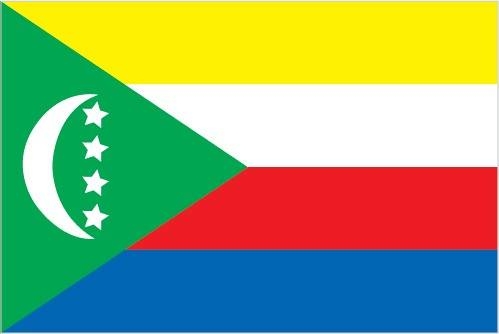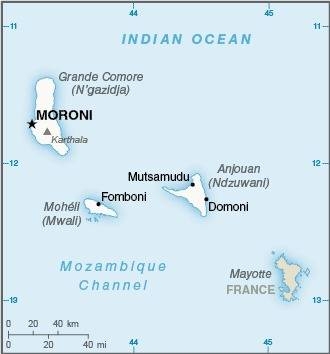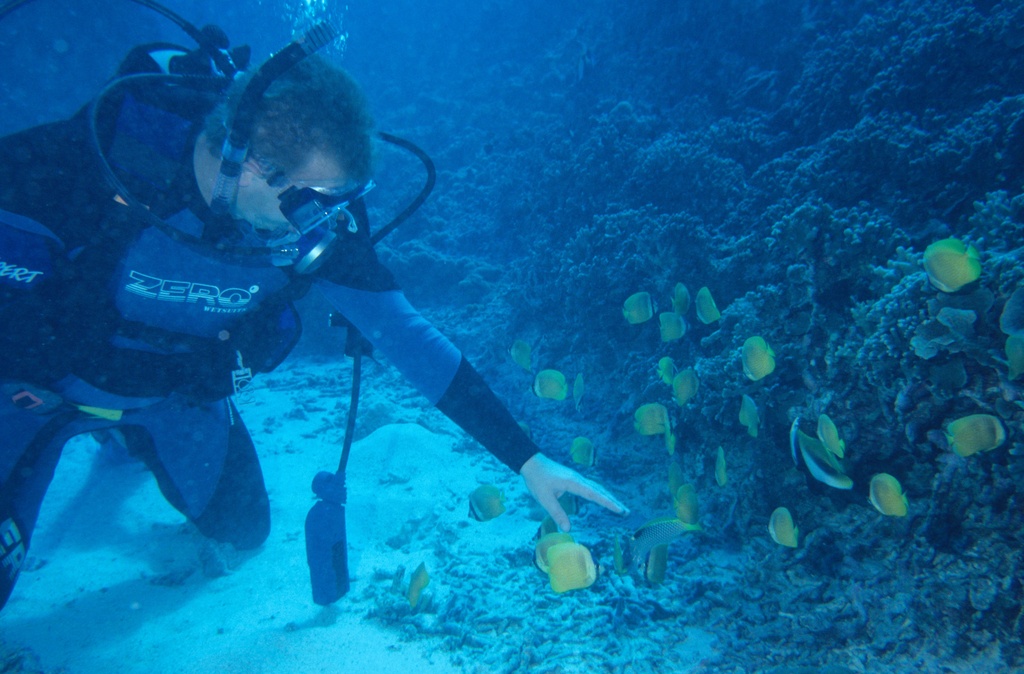187 Comoros

Four equal horizontal bands of yellow (top), white, red, and blue, with a green isosceles triangle based on the hoist. Centered within the triangle is a vertical white crescent moon with the convex side facing the hoist and four white, five-pointed stars placed vertically in a line between the points of the crescent. The horizontal bands and the four stars represent the four main islands of the archipelago – Mwali, N’gazidja, Ndzuwani, and Mahore (Mayotte – department of France, but claimed by Comoros).
Flag courtesy of the CIA World Factbook

Map courtesy of the CIA World Factbook

Comoros diver with fish
Government
According to Britannica, under the constitution of 2001, amended in 2009, 2014, and 2018, the islands of Grande Comore, Mohéli, Anjouan, and Mayotte form the Union of the Comoros. Mayotte, however, continues to be administered by France and does not participate in the government of the Union. Executive power of the federal government is vested in the president, assisted by three vice presidents. The president serves as head of state and government and is directly elected in nationwide elections to serve a five-year term, renewable once. Each vice president serves a five-year term and represents one of the three islands.
A constitutional referendum passed in 2009 included measures to reduce the federal governmental structure, change the island leadership positions of president to governor, and extend the term of the federal presidency from four to five years. A constitutional referendum passed in 2018 eliminated the single-term federal presidency that had rotated among the three islands since 2001. Other changes included designating Islam as the state religion and granting the president the power to eliminate the positions of the three vice presidents.
The unicameral legislature consists of the Assembly of the Union; members are elected to five-year terms. Slightly more than half the members are directly elected, with the remainder selected by the islands’ local governments.
In the late 1990s, secessionist movements on the islands of Anjouan and Mohéli threatened the stability of Comoros. The individual islands’ desire for greater independence in their own affairs was not provided for under the existing constitution (from 1996) and continued to be the source of much conflict. Changes brought about by the 2001 constitution granted the three main islands partial autonomy, and each elects its own president (later governor) and legislative assembly. The government of each island is free to administer its own affairs so long as its actions do not infringe upon the rights of the other islands or otherwise threaten the state of the federal union.
The 1996 constitution created a multiparty system, but stringent criteria severely limited the number of parties with legal recognition. The 2001 constitution removed these impediments, thus allowing political parties to operate freely. The country has universal suffrage, and women participate in all aspects of the economy. By the 1990s women had become cabinet members and held other positions in various governments.
The legal system is a combination of French and Islamic law. The judiciary is headed by the Supreme Court. Other components include the Higher Council of the Magistracy, which is mandated to aid the president in providing for an independent judiciary, and a Constitutional Court. There is also a High Council, which is concerned with constitutional and electoral matters and rules in conflicts involving the islands and the federal union.
National Agency for Civil Aviation and Meteorology (ANACM)
The General Directorate of Civil Aviation and Meteorology is a public institution of an administrative nature. It represents the Comoros at the ICAO and the World Meteorological Organization (WMO). It negotiates air agreements with other countries and is the guarantor of the application of the standards enacted to better understand the evolution of statistical information on paid traffic (passengers, freight and post), and studies the international regulations of air transport. . It oversees the Prince Said Ibrahim International Airport (AIMPSI), Com Air Assistance and the Agency for Air Navigation Safety in Africa and Madagascar (ASECNA). In the mid-1980s, the autonomous public airport establishment was created, which took over the management of the MORONI HAHAYA airport, providing air traffic services, thus relieving the General Directorate of Civil Aviation and Meteorology. In 2004, the Comorian State joined the Agency for Air Navigation Safety in Africa and Madagascar. The system thus continued until 2008 when we witnessed the transformation of the General Directorate of Civil Aviation and Meteorology (DGACM) into the National Agency for Civil Aviation and Meteorology ((ANACM).
Airspace
SkyVector – Google Maps – ADS-B Exchange
ICAO countries publish an Aeronautical Information Publication (AIP). This document is divided into three parts: General (GEN), En Route (ENR) and Aerodromes (AD). ENR 1.4 details the types of airspace classes they chose to adopt from classes A through G.
Drone Regulations
None found by the author.
However, should you, the reader, happen to stumble across something to the contrary, please email the author at FISHE5CA@erau.edu and you may be mentioned in the ACKNOWLEDGEMENTS section of this book by way of thanks for contributing to this free eBook!
Advanced Air Mobility (AAM) Regulations & Policies
None found by the author.
However, should you, the reader, happen to stumble across something to the contrary, please email the author at FISHE5CA@erau.edu and you may be mentioned in the ACKNOWLEDGEMENTS section of this book by way of thanks for contributing to this free eBook!
Advanced Air Mobility (AAM) News
None found by the author.
However, should you, the reader, happen to stumble across something to the contrary, please email the author at FISHE5CA@erau.edu and you may be mentioned in the ACKNOWLEDGEMENTS section of this book by way of thanks for contributing to this free eBook!
Short Essay Questions
Scenario-Based Question
You have been hired by a Drone Startup Company. Your boss has immediately assigned this job to you.
They need you to prepare a one-page memo detailing the legalities of using a drone to film in Comoros.
They need you to mention any national laws and local ordinances.
They specifically want to know what airspace (insert pictures) you will be operating in and whether or not you need an airspace authorization.
Does it matter whether or not you are a citizen of the country?
Lastly, there is a bonus for you if, as you scroll through this chapter, you find any typos or broken links!
Short Essay Questions
- What are the drone categories?
- How is registration addressed?
- How is remote ID addressed?
- What are the model aircraft rules?
- What are the commercial drone rules?
- Are there waivers or exemptions to the rules? If so, for what?
- Would you share a link to an interactive airspace map?
- How is BVLOS addressed?
- How can you fly drones at night?
- How can you fly drones over people?
- Where do you find drone NOTAMs?
- What are the rules for drone maintenance?
- What are the rules for an SMS program?
- What are some unique rules not mentioned above?
- What are the C-UAS rules?
- What are the AAM rules?

